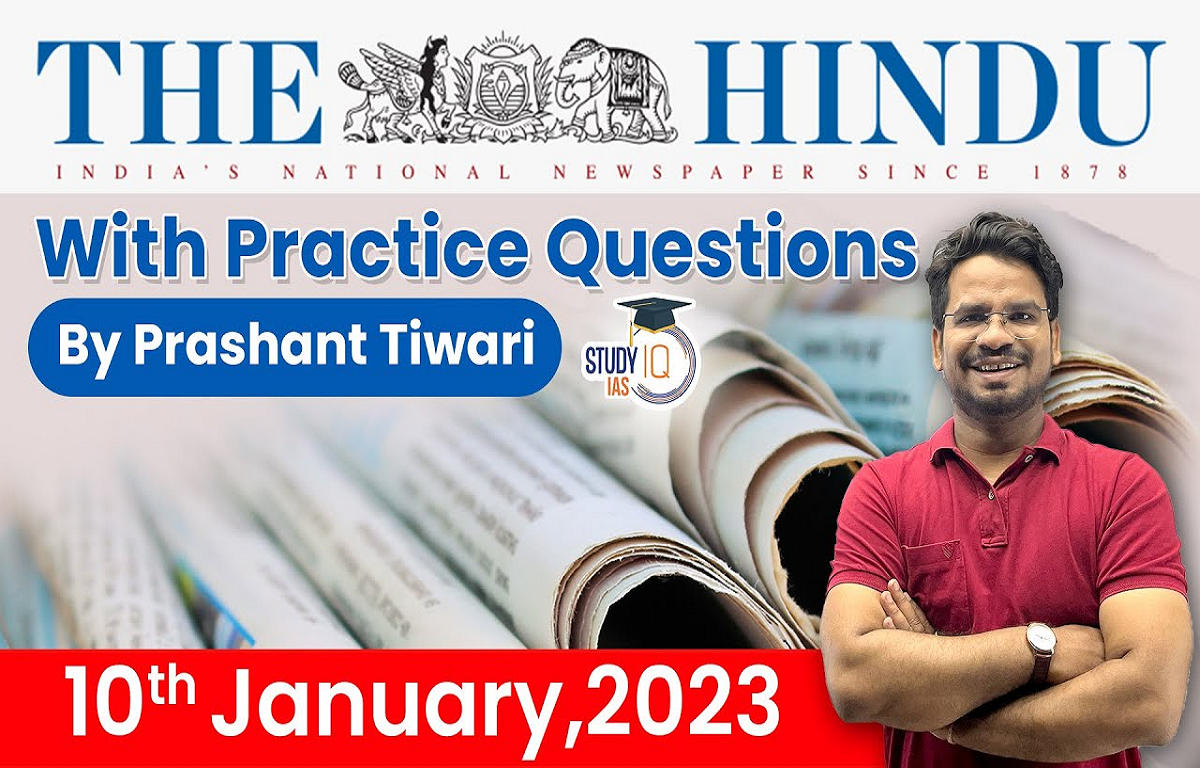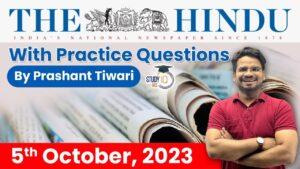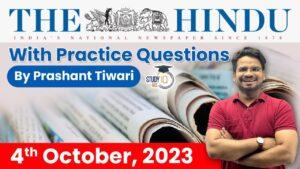The Hindu Newspaper Analysis for UPSC

The Hindu Newspaper Analysis 9 January 2023
- The Andhra Pradesh government has argued in its petition that the assets include 245 institutions and corporations specified under the Ninth and Tenth Schedules of the Andhra Pradesh Reorganisation Act, 2014.
- Indian constitution empowers the Union government to create new states out of existing states or two merge one state with other. This process is called reorganisation of the states.
- The basis of reorganisation could be linguistic, religious, ethnic or administrative.
- Article 3 provides the following procedure:
- Presidential reference is sent to State Assembly.
- After presidential reference, a resolution is tabled and passed in Assembly.
- Assembly has to pass a Bill creating the new State/States.
- A separate Bill has to be ratified by Parliament.
- Article 3 of Indian Constitution addresses the topic of ‘Formation of new States and alteration of areas, boundaries or names of existing States’. It says; Parliament may by law
- (a) form a new State by separation of territory from any State or by uniting two or more States or parts of States or by uniting any territory to a part of any State;
- (b) increase the area of any State;
- (c) diminish the area of any State;
- (d) alter the boundaries of any State;
- (e) alter the name of any State

- In November 2022, over four years after the gang rape and murder of an eight-year-old girl in Kathua, the Supreme Court held that one of the accused persons, who claimed to be a juvenile at the time of the commission of the offence, be tried as an adult.
- The claimed date of birth, which showed the accused to be approximately 15 years and two months old at the time of the commission of the offence, was published in the certificate issued by the local municipal committee.
- Therefore, despite provisions of the Jammu and Kashmir Juvenile Justice (Care and Protection of Children) Rules, 2014 stating that age could be determined based on school and municipality documents, the court held that these contradictory documents in this case did not inspire confidence regarding the minority status of the delinquent.
- The court relied upon the medical opinion of a team of five doctors on the basis of physical, dental and radiological examination that the approximate age of the respondent was over 19 years.
- The most popular test for determining age is the ossification test. The extent of ossification (i.e., calcification) and the union of epiphysis in bones, particularly long bones such as radius and ulna, humerus, tibia and fibula, and femur, are helpful in estimating age.
- The Supreme Court’s ruling referred to the technique of wisdom teeth (also known as third molars). This technique was already used to estimate age in the Kathua case. Though none of the four third molars were found to have erupted, an orthopantomogram (panoramic radiograph) examination showed root formation of the upper two molars and near-complete root formation of the lower molars. The average period of eruption of ‘third molars’, mentioned in Wheeler’s Dental Anatomy, Physiology, and Occlusion, is between the 17th and 21st year of age; and root formation is between the 18th and 25th year.
- Non-registration of birth by the ‘head of the house’ or hospital is punishable with a fine of up to ₹50 under the Registration of Births and Deaths Act, 1969.

- Petitioners are looking for an authoritative ruling legalising same-sex marriage, especially on the question of whether it will be brought within the ambit of the Special Marriage Act of 1954, which allows a civil marriage for couples who cannot marry under their personal law.
- After the transformational judgment in K.S. Puttaswamy (2017) upholding the right to privacy and Navtej Johar (2018) decriminalising homosexuality, the courts have shown the way to end uncertainty regarding the rights of the LGBTQIA+ community.
- Petitioners have argued that denying the community the same rights as heterosexual couples violates a clutch of fundamental rights on life and liberty including Articles 14, 19 and 21 of the Constitution and Article 16 of the Universal Declaration of Human Rights, to which India is a signatory.
- Article 16 says, “Men and women of full age, without any limitation due to race, nationality or religion, have the right to marry and to found a family”.
- By legalising same-sex marriage, India can join the 30-odd countries which allow it, and lead from the front in Asia where only Taiwan has legalised it.

- Many raised a red flag against a massive infrastructural project called the Char Dham road project that is being implemented in the Uttarakhand Himalaya. It is indeed turning out to be an unscientific road-construction project with catastrophic consequences for the mountain ecology.
- In the next decade, the Government proposes to build 66 tunnels in the Uttarakhand Himalaya and 18 tunnels are already in operation.
- Building these subsurface structures could result in gross damage to the environment, including the concentration of pollutants from traffic exhaust compounded by a microenvironment with no sunlight and limited dispersion in such long-distance tunnels.
- The construction of highways and railway tracks has now become a prime cause for landslides and its occurrences have doubled over the years. The increased anthropogenic activities such as road construction have made the hill slopes extremely unstable. That is why the recurring landslides have gone up in numbers in the Himalayas.
- Irreversible impact on groundwater like descending water levels has been observed in the areas of tunnel construction.Erratic rainfall and ecological degradation associated with land use change for infrastructural development are already impacting mountain aquifer systems. Groundwater use in the Himalayan States differs from that in the plains, as large and contiguous aquifers do not exist in the hills.
- The Himalayan terrain demands sustainable tourism, not mass tourism. The daily average footfall last year along the Char Dham route was reported to be around 58,000. Ground reports also say that plastic waste dumped in pits and the cleaning operations resorting to open burning are highly hazardous.
- A development strategy for the Himalayas should not come at the cost of the environment.It should be primarily based on the region’s natural resources such as forest, water, biodiversity and ecotourism. Rather than building massive dams, focus should be on small projects that would be helpful in providing local energy supply.

- The combined budget of all the municipal corporations in India is much smaller than that of the Central and State governments, an RBI analysis of finances of urban local bodies concludes.
- The study titled “Report on municipal finances” reveals how municipal bodies are increasingly dependent on fund transfers from the State and the Centre, while their revenue earning capacity is limited.
- Taxes earned by municipal corporations in India are grossly inadequate to meet their expenditure needs. In India, the own tax revenue of municipal corporations, comprising property tax, water tax, toll tax and other local taxes, formed 31-34% of the total revenue in the FY18-FY20 period.
Q) Consider the following statement:
- Constitution of India fixed period of census for every 10 years.
- India has held its decadal censuses regularly from 1881 to 2011.
Which of the above statements is/are Not correct?
- 1 only
- 2 only
- Both 1 and 2
- Neither 1 nor 2
निम्नलिखित कथन पर विचार करें:
- भारत के संविधान ने प्रत्येक 10 वर्षों के लिए जनगणना की अवधि निर्धारित की।
- भारत ने अपनी दशकीय जनगणना 1881 से 2011 तक नियमित रूप से आयोजित की है।
उपरोक्त कथनों में से कौन-सा/से सही नहीं है/हैं?
- केवल 1
- केवल 2
- 1 और 2 दोनों
- न तो 1 और न ही 2
- It was systematized during the years 1865 to 1872, though it has been conducted uninterruptedly from the year 1881 being a trustworthy resource of information.
- India has held its decadal censuses regularly from 1881 to 2011, despite diseases, world wars, Partition and other instances of turmoil only COVID-19 as an exception.
- The Constitution talks about the use of Census data for delimitation of constituencies and for determining the quantum of reservation for Scheduled Castes and Scheduled Tribes. However, it does not say what should be the periodicity of the census. The Census Act, 1948, which predates the Constitution, provides the legal background for several activities relating to the Census without mentioning anything about its periodicity.
Q) Consider the following statement:
- Jallikattu is a traditional sport that is popular in the Indian state of Tamil Nadu.
- Article 29 available to citizen of India only.
Which of the above statements is/are Incorrect?
- 1 only
- 2 only
- Both 1 and 2
- Neither 1 nor 2
निम्नलिखित कथन पर विचार करें:
- जल्लीकट्टू एक पारंपरिक खेल है जो भारतीय राज्य तमिलनाडु में लोकप्रिय है।
- अनुच्छेद 29 केवल भारत के नागरिकों के लिए उपलब्ध है।
उपरोक्त में से कौन सा/से कथन गलत है/हैं?
- केवल 1
- केवल 2
- 1 और 2 दोनों
- न तो 1 और न ही 2
- Jallikattu is a traditional sport that is popular in the Indian state of Tamil Nadu.
- The sport involves releasing a wild bull into a crowd of people, and the participants attempt to grab the bull’s hump and ride it for as long as possible, or attempt to bring it under control.
- It is celebrated in the month of January, during the Tamil harvest festival, Pongal.
What are the Associated Concerns?
- The primary question involved was whether Jallikattu should be granted constitutional protection as a collective cultural right under Article 29 (1).
- Article 29 (1) is a fundamental right guaranteed under Part III of the Constitution to protect the educational and cultural rights of citizens.
- The court examined if the laws “perpetuate cruelty to animals” or were actually a means to ensure “the survival and well-being of the native breed of bulls”.
- The five-judge Bench heard parties on whether the new Jallikattu laws were “relatable” to Article 48 of the Constitution, which urged the state to endeavor to organize agriculture and animal husbandry on modern and scientific lines.
Q) The ‘Eat Right Station’ certification is awarded by
- Bureau of Indian Standards
- Food Safety and Standards Authority of India
- Quality Council of India
- none of the above
‘ईट राइट स्टेशन’ प्रमाणन किसके द्वारा प्रदान किया जाता है?
- भारतीय मानक ब्यूरो
- भारतीय खाद्य सुरक्षा और मानक प्राधिकरण
- भारतीय गुणवत्ता परिषद
- उपर्युक्त में से कोई नहीं
Explanation:
- The ‘Eat Right Station’ certification is awarded by FSSAI to railway stations that set benchmarks in providing safe and wholesome food to passengers.
- The apex food regulatory body comes under the Ministry of Health and Family Welfare
Q) Consider the following statements about National Single window system (NSWS):
- It was created by the Ministry of Finance.
- The portal is envisioned as a one-stop shop for investors for taking all the regulatory approvals and services related to investments.
Which of the above statements is/are correct?
- 1 only
- 2 only
- Both 1 and 2
- Neither 1 nor 2
नेशनल सिंगल विंडो सिस्टम (NSWS) के बारे में निम्नलिखित कथनों पर विचार करें:
- इसे वित्त मंत्रालय द्वारा बनाया गया था।
- पोर्टल को निवेशकों के लिए निवेश से संबंधित सभी विनियामक अनुमोदन और सेवाओं के लिए वन-स्टॉप शॉप के रूप में देखा गया है।
उपरोक्त कथनों में से कौन-सा/से सही है/हैं?
- केवल 1
- केवल 2
- 1 और 2 दोनों
- न तो 1 और न ही 2
Explanation:
- Various government schemes including Vehicle Scrapping Policy, Indian Footwear and Leather Development Policy (IFLDP), and Sugar and Ethanol Policy onboarded on NSWS
- NSWS was launched in September 2021 (Ministry of Commerce and Industry)
- Currently, Investors can apply for approvals from 27 Central Ministries/Departments and 19 States/UTs on the portal.
- The portal is envisioned as a one-stop shop for investors for taking all the regulatory approvals and services related to investments.
Q) Consider the following statements about National Beekeeping & Honey Mission (NBHM)
- It is a Central Sector Scheme.
- It is implemented through the Central Silk Board.
- It aims for the overall promotion & development of scientific beekeeping in India.
Which of the statements given above is/are correct?
- 1 and 2 only
- 2 and 3 only
- 1 and 3 only
- 1, 2 and 3
राष्ट्रीय मधुमक्खी पालन और शहद मिशन (NBHM) के बारे में निम्नलिखित कथनों पर विचार करें
- यह एक केंद्रीय क्षेत्र की योजना है।
- इसे केंद्रीय रेशम बोर्ड के माध्यम से कार्यान्वित किया जाता है।
- इसका उद्देश्य भारत में वैज्ञानिक मधुमक्खी पालन के समग्र प्रचार और विकास करना है।
ऊपर दिए गए कथनों में से कौन सा/से सही है/हैं?
- केवल 1 और 2
- केवल 2 और 3
- केवल 1 और 3
- 1, 2 और 3
Explanation:
- NBHM is a Central Sector Scheme, approved under the Aatma Nirbhar Bharat announcement, and implemented through National Bee Board (NBB).
- NBHM aims for the overall promotion & development of scientific beekeeping in the country to achieve the goal of ‘Sweet Revolution’ which is being implemented through NBB.
- Under the scheme, the main thrust is given on awareness, capacity building/training, focus on women empowerment through beekeeping and setting up of requisite infrastructural facilities.
Mains Practice Question:
Q) “A man is but the product of his thoughts. What he thinks he becomes.” — M.K. Gandhi (150 words)
“एक आदमी अपने विचारों का उत्पाद है। वह जो सोचता है वह बन जाता है। — एम.के. गांधी (150 शब्द)
Introduction:
- Mahatma Gandhi in his book “My Experiments with Truth” has shown how his thought process was influenced by his upbringing, experiences and his strong beliefs.
- Similarly, through this statement Mahatma Gandhi means that the actions of a person are largely determined by her thought process.
Body:
How thought influences the attitude and behavior of a person
- One’s thoughts are the first engagement points with society.
- Thoughts impact behavior as well as the attitude, while molding the actions. It, therefore, becomes very important for the thoughts to be fixated to a compass of morality and conscience.
- Ethical behavior and regulation of actions emerge from the ethical thought process.
- Thoughts or reflections on experiences open up possibilities for the choices of action to be taken.
- An understanding and awareness of one’s thoughts and feelings or emotional intelligence can help in regulating her actions accordingly. For example, while thoughts of kindness and compassion can create more empathetic individuals, thoughts of violence and anger can contribute to the making of criminals in society.
- Individuals’ thinking has become more self-centered under the impact of increasing individualism and consumerism, this has further led to the individuals’ detachment from the community and society.
Conclusion:
- It is in these times that people’s ability to think freely in a society should be nurtured. Societies need to emphasize more on education as the inculcation of critical ethical thinking can produce individuals who act ethically, thereby impacting society, nation and the world at large.
Mains Practice Question:
Q) Discuss the role of women in the freedom struggle especially during the Gandhian phase. (2016) (250 words)
स्वतंत्रता संग्राम में विशेषकर गांधीवादी दौर में महिलाओं की भूमिका की चर्चा कीजिए। (2016) (250 शब्द)


 The Hindu Newspaper Analysis 6 October 2...
The Hindu Newspaper Analysis 6 October 2...
 The Hindu Newspaper Analysis 5 October 2...
The Hindu Newspaper Analysis 5 October 2...
 The Hindu Newspaper Analysis 4 October 2...
The Hindu Newspaper Analysis 4 October 2...

















